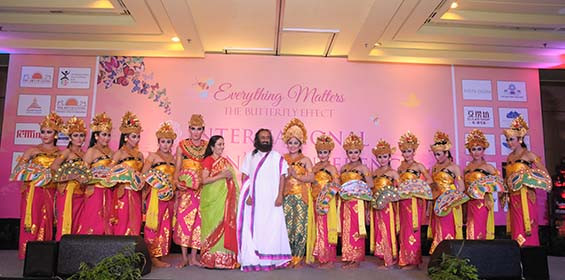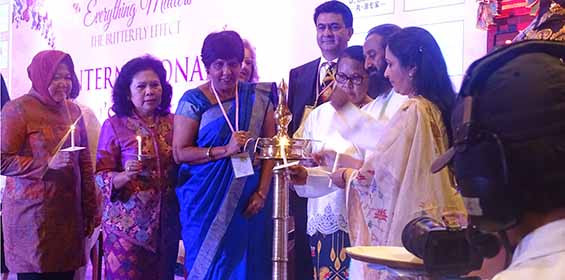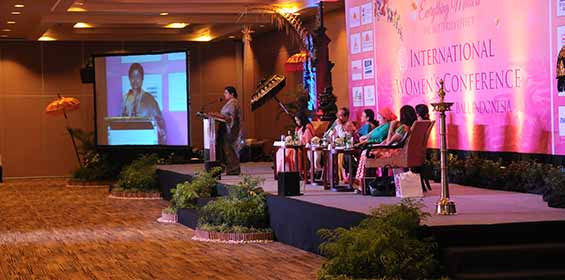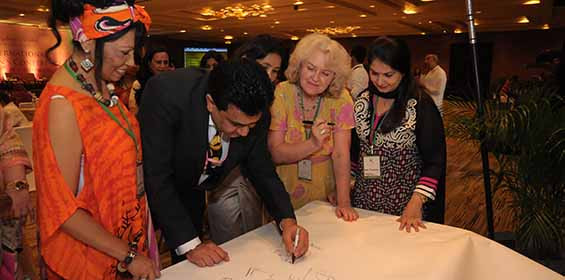Excerpts from the Speech of Dr. D K Hari Conceptualizer and Founder of Bharath Gyan.
Jai Gurudev. Swasti Astu. First of all, before we start, I would like to thank Bhanu didi for inviting both, my wife and myself to be here in this wonderful conference and make a small presentation on the concept of butterfly which is the theme of the whole program.
Ok. So when we speak about butterfly, how it flaps its wings is what we have seen. So let’s see what this butterfly is all about and this concept of butterfly, the world over. It’s one insect that is all over the world and it’s been recorded right from very ancient times all across the world. Let’s take probably, since we all speak English, let’s take England, Holland, that area first. I am going to say something gross now. Do you know how the word ‘butterfly’ came about? Any idea, anybody? Ok. The excreta of a butterfly looks like butter. So they called it buttershit and some good person thought to make it better, so they called it butterfly. Actually in Old Dutch language, it’s still called buttershit. Unfortunately, that’s how it came about and a butterfly’s wanting its taste buds are its feet, its pods, pada- feet. So that’s why taste buds are. Ok, let’s go to Greek civilization. Do you know what they called the butterfly? Psyche. So the word psychology, psychiatry, psychic, psyche, all deal with soul as well as the butterfly. So they equated a soul with butterfly. That’s what they did and one of the persons who spoke quite a bit about psyche, that is butterfly, and about soul is Aristotle, the great scholar of ancient Greece. So look at all these words, psychiatry, psychology. All this comes from psyche, meaning, butterfly as well as soul. Both are equal- butterfly and soul. About how the concept of butterfly and soul came about. We’ll talk in the next session. So I’ll just go about the next step. So its not there in Vedas, its there in all civilizations. They looked at it from that perspective. And there were the myths of psyche where you are looking for something that is just not there, that’s also there. Ok, let’s go to Egypt, shall we? Ok. Look at this in Egypt. In the Kartoosh, where there were the mummies there also they got the butterfly, meaning, the soul because the soul goes across generations. It’s shown there also. Small clipping below the foot of the person. Its there, that’s the circle, so you can see there in the Egyptian painting. Ok. And its there all the Egyptian Mummies would also see it and there’s a famous article. I’ll come to that later. Then going on to the American continent. They had this famous butterfly which we call as the Monarch butterfly which is slowly going, this is what we speak. The key factor about this butterfly is, when it migrates from North Canada to Mexico, it takes about 3-4 lifetimes of a butterfly to migrate one way. So, it’s if a grandfather butterfly starts on this one way seasonal migration, it’s the great grand child butterfly which reaches Mexico. And there it starts remigration back. It again takes 3-4 generations more. If there was no soul how would they know 8 generations later they have to go back? There’s this one thing I tell you how beautifully, and that is the butterfly we are trying to destroy now, which speaks about. It is amazing, isn’t it? It’s not that we know the path, we can go straight away. It’s just across generations, across ages, they know the path inherently in them that comes, that’s a beautiful explanation. Here, in the Bhasa language in Indonasia, Bali, you know what that is called Kupukupu. Ok and let’s get to India, the land where we are from my wife and myself I am going to look at few places for butterfly.
Let’s look at if you want the Hindi language term. In the national language, it’s called Titli and there are many poems, songs, from film songs to poetry and children’s poetry; all that which inspires people about butterfly. Ok let’s get on to say, in the State of Orissa, it’s called chitrapatanga. Why is it called patanga we’ll see? Chitra means painting that’s beautiful. Patanga also means a kite. Let’s see why it means a kite. I’ll leave the suspense. She’ll come and explain that. And in the State of Andhra Pradesh, it is called seetakokachiluka, meaning it’s like a saree (as worn in most of India), which a lady wears in which there are butterfly imprints. It’s like seeta saree. That’s what it’s called. It’s so beautiful, how each language, each region looks at the butterfly. Going on to Tamil Nadu (again down South), its called Pattampoochi. Poochi, it says. Pattam, it says. It’s so beautiful. Ok. It’s like a kite. That’s how they show it and in Kerala, they call it Chitrashalabham. Everywhere they link it to paintings, link it to various aspects of beauty and going on to Sindh as well as Gujarat region, the Sankranti festival in those regions, which marks the onset of sun coming northwards, what you call as Uttarayan, that area’s big festival that’s called Sankranti, is celebrated. In Thailand, it’s called Shankaron and they are celebrated with kites, all made in the shape of butterfly. Look at how a concept is taken into festivals and celebration. On this festival, not just the butterfly, the markets are colourful, and also the people. Look at the varieties of butterfly that fly. I mean what you call the kites, patanga. The Prime Minister of India takes part every year in this festival. So that’s the thing.
Now I am going to speak about a few opinions about butterfly. Let’s look at Richard Bach, the famous author who has written many books on butterfly. Look at what he says, “What a caterpillar calls the end of the world the rest of the world calls a butterfly”. So beautiful! So what you thought was the end is the next beginning, that’s what Richard Bach says. Going on to Mohammad Ali or you want to do Jones? Ok. Look, as she speaks about the immortality of a butterfly in the Egyptian belief, she speaks about a butterfly in all mummies in Sarcophagus in Egypt as that’s what she sees. There she mentions that in her book and then coming on to Mohammad Ali. I am sure most of you heard about this very famous quote of Mohammad Ali, “I float like a butterfly and sting like a bee”. All of us have heard of this concept right through the ages. All through the lands, all through civilizations and generations, you got the concept of butterfly expressed by many people and also the butterfly bee barometer as all of us have been talking that this is the key barometer. The way we’ve got thermometer, and all those meters, this is the real barometer of environment! That’s what we need to keep in mind. I think the next aspect we are going to speak about is how a butterfly has been expressed in the Indian tradition right through the ages, right from Vedas. Actually when Bhanu didi asked us to make the presentation, we started searching in the Vedas if there was any mention of a butterfly and most of you would be happily surprised, 3 verses in the Vedas speak about the butterfly so beautifully and i think Hema should share with you the same because she was the person who got on to it and spend a lot of time in doing research on those 3 verses alone of the Vedas. So, she will do it.

















